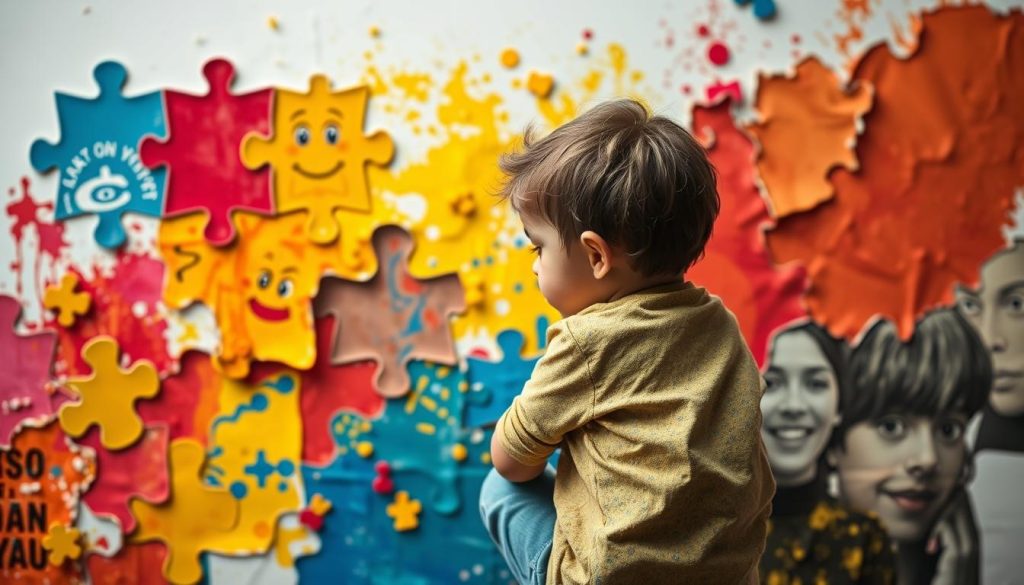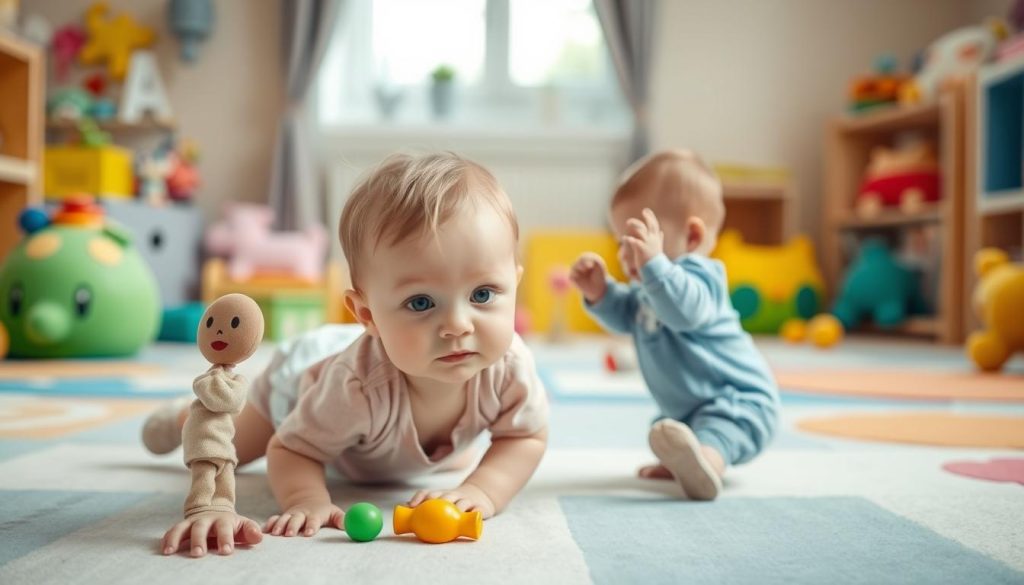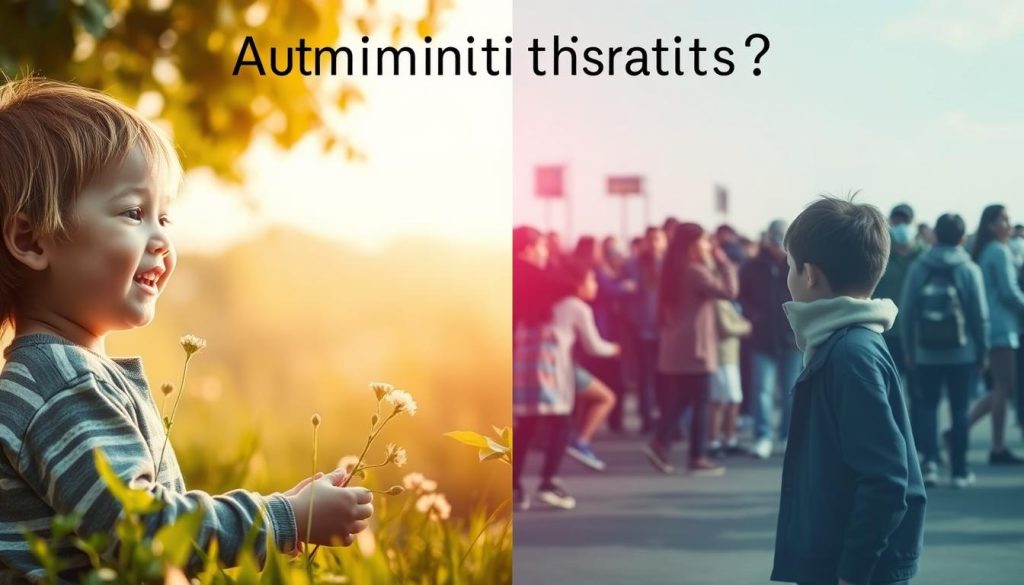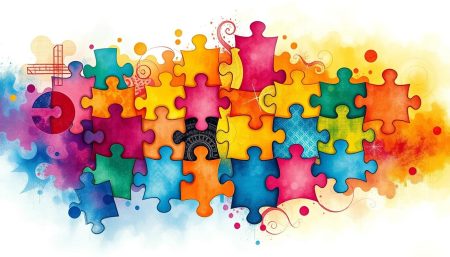As a parent, you want the best for your child. Knowing the signs of autism can help you spot concerns early. This guide will help you understand autism symptoms and early signs.
Autism spectrum disorder changes how children interact, communicate, and behave. By knowing these signs, you can support your child’s growth. Remember, every child is different, and early help can make a big difference.
In this guide, we’ll look at key signs of autism, like social challenges and sensory differences. We’ll also talk about when to ask for help from healthcare professionals. Let’s learn more about recognizing autism signs in young children.
Understanding Autism Spectrum Disorder: An Overview
Autism Spectrum Disorder (ASD) is a complex condition that affects how people interact and communicate. Recognizing autism early can greatly impact a child’s life. The spectrum nature of ASD means signs and symptoms vary greatly from person to person.
Autism signs often show up in early childhood. These can include challenges with social skills, repetitive behaviors, and communication issues. It’s important to remember that every child develops at their own pace. Yet, certain red flags may suggest the need for further evaluation.
Early detection of autism signs is key. Parents are vital in recognizing autism by observing their child’s behavior and development. If your child struggles with social interactions or shows unusual behaviors, it’s wise to consult a healthcare professional.
| Common Autism Spectrum Disorder Signs | Age of Appearance |
|---|---|
| Limited eye contact | 6-12 months |
| Delayed language skills | 12-18 months |
| Repetitive behaviors | 18-24 months |
| Difficulty with social interactions | 24-36 months |
Remember, autism is not a one-size-fits-all diagnosis. Each child’s experience is unique, and support should be tailored to their specific needs. By understanding the basics of ASD, parents can better advocate for their children and seek appropriate interventions when necessary.
What Are Signs of Autism: Key Indicators for Parents
It can be tough for parents to spot autism in kids. Autism traits and behaviors are diverse. Yet, some key signs can alert you to possible issues. Let’s look at the main autism signs to watch for in your child.
Social Communication Challenges
Children with autism often find social interactions hard. They might not make eye contact or understand social cues well. Some kids might not respond to their name or share by pointing or showing objects.
Repetitive Behaviors and Routines
Autism behaviors include repetitive actions and strict routines. Your child might do things like hand-flapping or rocking. They might also get upset if their routines change.
Sensory Processing Differences
Many kids with autism have unique sensory responses. They might be too sensitive to sounds, lights, or textures. Some seek intense sensory experiences, while others avoid certain sensations.
| Category | Common Signs | Examples |
|---|---|---|
| Social Communication | Limited eye contact, difficulty with conversation | Not responding to name, avoiding group play |
| Repetitive Behaviors | Repeated movements, strict routines | Hand-flapping, lining up toys |
| Sensory Processing | Unusual reactions to sensory input | Covering ears in noisy places, refusing certain textures |

Remember, autism traits show up differently in each child. If you see several of these signs often, talk to a healthcare professional. They can help with further evaluation.
Social Development Red Flags in Young Children
It’s key to spot autism signs in social skills early. Parents should watch for autism signs in their child’s early years.
Limited Eye Contact and Social Engagement
Children with autism often have trouble making eye contact. They might not look at people or seem not to care about social talks. This is often one of the first signs parents notice.
Delayed Language Development
Language delays are a common sign of autism. Some kids don’t babble or use gestures by 12 months. Others might not say single words by 16 months or two-word phrases by 24 months. These signs can mean there’s a problem.
Difficulty with Peer Relationships
Children with autism often have a hard time making friends. They might like to play alone, not get social cues, or struggle with sharing. These issues can show they might have autism.
If you see these signs in your child, talk to a doctor. Early help can greatly improve their future.
Communication Patterns and Language Development
It’s key to understand how kids communicate to spot autism early. Kids with autism often talk differently, which is a big clue. Many parents first notice their child’s language isn’t developing as expected.

Delayed speech is a big worry. Some kids with autism don’t say their first words by 12 months. Others might start talking but find it hard to keep a conversation going. This shows they struggle with social communication, a big sign of autism.
Echolalia, or repeating words and phrases, is another sign. A child might repeat what they hear right away or later. This is different from how most kids talk.
Non-verbal communication can also be tricky. Kids with autism might find it hard to:
- Use gestures like pointing or waving
- Understand facial expressions
- Make eye contact
These communication challenges are important signs of autism. If you see these in your child, talk to a healthcare provider. Early help can make a big difference in their development.
Behavioral Signs That May Indicate Autism
Spotting autism behaviors and traits early is key for parents. Every child grows at their own pace. Yet, some patterns might hint at a need for more checks.
Repetitive Movements and Stimming
Autistic kids often do repetitive actions, like hand-flapping or spinning. These actions help them manage their feelings and what they sense around them.
Resistance to Change
Many autistic children like their routines a lot and find it hard to adjust. They might get upset if their daily plans change or if they’re asked to do something different suddenly.
Intense Focus on Specific Interests
Another common sign is having very strong, narrow interests. A child might really get into something like trains or dinosaurs, learning lots about it.
| Autism Behavior | Description | Example |
|---|---|---|
| Stimming | Repetitive self-stimulatory behaviors | Hand-flapping, rocking |
| Routine Adherence | Strong preference for sameness | Distress when routines change |
| Intense Interests | Deep focus on specific topics | Memorizing facts about space |
Knowing about these autism behaviors can guide parents to get the right help. If you see these signs in your child often, talk to a doctor about it.
Physical Development and Motor Skills
Physical development and motor skills are key signs of autism in children. Kids with autism often move and develop differently. These differences can be small or quite noticeable.

Fine motor skills, like writing or buttoning, may grow slower in some autistic kids. Gross motor skills, such as running or jumping, can also be affected. Some children might have an unusual way of walking or standing.
Parents should watch for physical milestones. If a child is always behind in these, it’s a sign to talk to a doctor.
| Age | Typical Milestone | Potential Autism Sign |
|---|---|---|
| 6 months | Rolls over | Difficulty rolling or limited movement |
| 12 months | Walks with support | Not crawling or pulling to stand |
| 18 months | Scribbles with crayon | Struggles to grasp objects |
| 2 years | Runs easily | Unusual gait or toe-walking |
Every child grows at their own speed. If you see several signs or worry about your child’s development, see a pediatrician. Early detection can help with support and interventions.
Sensory Processing and Response Patterns
Spotting autism often means noticing special ways kids handle sensory inputs. Kids with autism might act differently in everyday situations. This can help spot autism early on.
Unusual Reactions to Sounds
Kids with autism might cover their ears in loud places or seem not to hear. Some find comfort in certain sounds, like humming. These odd reactions to sounds are important signs of autism.
Sensitivity to Touch and Textures
Kids with autism often have trouble with touch. They might not like hugs, certain clothes, or even light touches. They might also keep touching or mouthing things for sensory reasons.
Visual Processing Differences
Autism symptoms also show in how kids see things. Some are drawn to spinning or flashing lights. Others might not want to look at people or see things from odd angles. These visual differences are clues to spotting autism early.
Getting to know these sensory patterns helps parents and caregivers support kids with autism. Remember, every child is different. Getting a professional diagnosis is essential for the right support.
Age-Specific Developmental Milestones
It’s important to know about developmental milestones for each age. This helps spot early signs of autism. Every child grows at their own pace, but some autism signs show up at certain ages.
By 6 months, babies usually smile and show happiness. Babies with autism might not show these social signs. At 9 months, babies usually respond to their name and start babbling. If they don’t, it could be a sign of autism.
By 12 months, most babies point at things and use simple gestures. Kids with autism might find these hard. By 16 months, most say their first words. If your child is late to talk, it could mean autism.
At 24 months, typical toddlers use two-word phrases and play pretend. Kids with autism might struggle with these. By 36 months, most show interest in other kids and express many emotions. If your child doesn’t interact with peers or show many emotions, it could be autism.
Keep in mind, these are just guidelines. If your child misses several of these milestones, see a doctor. They can do a detailed check-up.
Early Intervention and Its Impact
Spotting autism signs early is key for a child’s growth. Early programs tackle these signs and help kids learn vital skills.
Types of Early Intervention Programs
There are many programs for kids with autism:
- Applied Behavior Analysis (ABA)
- Speech and Language Therapy
- Occupational Therapy
- Social Skills Training
Benefits of Early Detection
Finding autism signs early brings big benefits:
- Boosts social and communication skills
- Improves cognitive growth
- Leads to better long-term results
- Reduces need for intense treatments later
Working with Healthcare Providers
Teamwork with healthcare pros is vital for autism care. Regular visits and talking with doctors, therapists, and experts ensure your child gets the best care.
| Healthcare Provider | Role in Autism Care |
|---|---|
| Pediatrician | Initial screening and referrals |
| Developmental Pediatrician | Diagnosis and treatment planning |
| Speech Therapist | Language and communication skills |
| Occupational Therapist | Daily living and motor skills |
Common Misconceptions About Autism Signs

Many parents find it hard to spot autism traits and behaviors. This leads to common misconceptions about autism signs. Let’s clear up some of these misunderstandings to help you better recognize signs in your child.
One widespread myth is that all children with autism avoid eye contact. While some may struggle with eye contact, others maintain it well. Autism behaviors vary widely among individuals.
Another misconception is that autism always involves intellectual disabilities. In reality, many people with autism have average or above-average intelligence. Autism traits can manifest differently in each person.
| Misconception | Reality |
|---|---|
| All autistic children have special talents | Some may have exceptional skills, but it’s not universal |
| Autism is caused by bad parenting | Autism is a neurodevelopmental condition, not a result of parenting |
| Children with autism don’t want friends | Many desire friendships but struggle with social skills |
It’s important to remember that autism is a spectrum. Not all autism behaviors will be present in every child. Some may show strong language skills but struggle with social cues, while others might excel socially but have repetitive behaviors.
By understanding these misconceptions, you can better recognize autism signs in your child. Then, seek professional guidance when needed.
When to Consult a Healthcare Professional
It can be hard for parents to spot autism spectrum disorder signs. If you see delays in development or odd behaviors, getting help is key. Early action can really help your child.
Screening Tools and Assessments
Doctors use special tools to check for autism. These include:
- Modified Checklist for Autism in Toddlers (M-CHAT)
- Autism Diagnostic Observation Schedule (ADOS)
- Childhood Autism Rating Scale (CARS)
These tools help find signs of autism and if more tests are needed.
Finding Qualified Specialists
To get a right diagnosis, look for experts in autism. You might find:
- Developmental pediatricians
- Child psychologists
- Pediatric neurologists
Ask your doctor for names or check with autism support groups for tips.
Preparing for Medical Consultations
Before your visit, collect info on your child’s growth and actions. Keep a log of:
- Social interaction patterns
- Communication skills
- Repetitive behaviors or interests
This info helps doctors spot autism and give a correct diagnosis.
Supporting Your Child Through the Diagnostic Process
The journey of diagnosing autism can be overwhelming for parents. Recognizing signs of autism in children is just the first step. Supporting your child during this time is key for their well-being and future.

Maintaining routines can provide comfort and stability. Keep your child’s daily schedule consistent, even with appointments and assessments. This familiarity can help reduce anxiety and stress for both you and your child.
Create a positive environment at home. Celebrate your child’s strengths and unique qualities. Focus on their abilities, not perceived deficits. This can boost their confidence and self-esteem during a challenging time.
Emotional support is key. Be patient and understanding as your child may struggle with changes or new experiences. Offer extra hugs, reassurance, and quality time together. Your love and acceptance are powerful tools in supporting your child’s growth.
| Support Strategies | Benefits |
|---|---|
| Maintain routines | Reduces anxiety, provides stability |
| Celebrate strengths | Boosts confidence, builds self-esteem |
| Offer emotional support | Enhances security, strengthens bond |
| Educate yourself | Improves understanding, aids advocacy |
Educate yourself about indicators of autism and the diagnostic process. This knowledge will empower you to advocate for your child’s needs. Remember, you’re not alone in this journey. Seek support from professionals, support groups, and other parents who have gone through similar experiences.
Resources and Support Networks for Parents
Learning about autism symptoms can feel overwhelming, but you’re not alone. The Autism Society of America offers a lot of information. They help connect parents with local chapters. Their website has educational materials and links to support groups across the country.
Autism Speaks is another great resource. They have a free 100 Day Kit for families just starting out. It covers early signs and treatment options. Their online forums let parents share experiences and advice on recognizing autism symptoms.
The National Autism Association offers hands-on support. They provide toolkits, webinars, and safety resources. Their First Signs program helps parents spot early signs of autism and guides them on what to do next.
Remember, these organizations are here to help you understand autism symptoms and offer support. Don’t hesitate to reach out and connect with other parents. You’ll find a caring community ready to share knowledge and offer encouragement.
FAQ
Q: What are the main categories of autism signs parents should watch for?
A: Autism signs include challenges with social communication, repetitive behaviors, and sensory processing. Look at how your child interacts, communicates, and reacts to sensory inputs.
Q: At what age can autism typically be diagnosed?
A: Autism can be diagnosed as early as 18 months. But, a reliable diagnosis is often possible by age 2. Many children are diagnosed later in childhood. Early signs can be seen in the first two years.
Q: What are some early signs of autism in toddlers?
A: Early signs include limited eye contact and delayed language. Not responding to their name and not pointing or waving are also signs. Unusual reactions to sensory inputs and repetitive behaviors are indicators too.
Q: How does autism affect language development?
A: Autism can impact language in different ways. Some may have delayed speech, while others might struggle with conversations. Echolalia and difficulty with non-literal language are common too.
Q: What is stimming and is it always a sign of autism?
A: Stimming is repetitive movements or sounds, like hand-flapping or repeating words. It’s common in autism but not exclusive. The frequency and intensity can be an indicator.
Q: How do sensory processing differences manifest in children with autism?
A: Children with autism may react differently to sensory inputs. They might be overly sensitive or seem under-responsive. They might cover their ears in loud places or seek intense sensory experiences.
Q: What should I do if I suspect my child might have autism?
A: If you suspect autism, talk to your pediatrician or a developmental specialist. They can do screenings and refer you for a full evaluation. Early intervention is key.
Q: Are there any physical signs of autism?
A: Autism is mostly about behavioral and developmental signs. But, some physical signs might be present. These include unusual gait or posture, delays in motor skills, or repetitive movements. These signs should be considered with other signs.
Q: Can autism be cured?
A: Autism is a lifelong condition and cannot be cured. But, early intervention and therapies can improve outcomes and quality of life. Many people with autism lead fulfilling lives with the right support.
Q: How does autism affect social skills?
A: Autism can impact social skills in many ways. It can make understanding social cues hard, make conversations challenging, and limit interest in peers. It can also affect empathy and perspective-taking. But, these challenges vary among individuals.


















